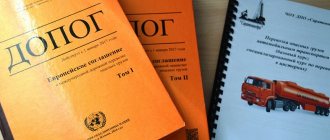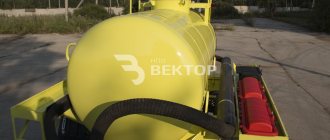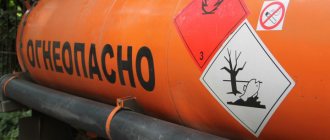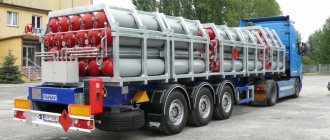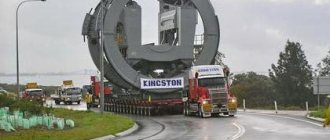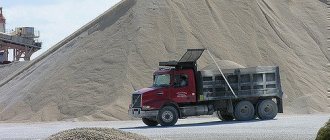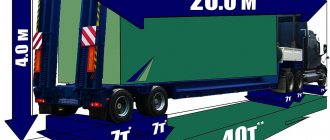Author of the article
Evgeniy Sergeevich Kobzar
Reading time: 10 minutes
AA
What is ADR and what provisions does it include? The document is aimed at facilitating the procedure for registration and transportation of goods classified as dangerous.
In order not to “get lost” in a large document, in order to have unique tips at hand, you should familiarize yourself with the information below. Here is a short set of rules, the structure of the ADR provisions, as well as small practical recommendations and justifications for preparing documentation.
What is dangerous goods?
Substances and products whose chemical properties or technical features cause danger to humans and the environment are classified as dangerous goods. JSC Avtokolonna 1989 transports dangerous goods throughout St. Petersburg, Russia, Europe and Asia.
When transporting goods classified as dangerous, it is necessary to follow the standards of international transportation. Previously, Russia had its own regulatory act, which contained the rules for the road transport of dangerous goods within the country. But starting from 2022, the European Agreement - ADR - is in force on the territory of the Russian Federation, which contains standards for the road transport of dangerous goods. The document covers all issues: cargo classes; rules of loading, transportation, labeling; container requirements; driver actions in emergency situations, etc.
Requirements for a car when obtaining a permit
The driver will be refused to issue documents in the following cases:
- Lack of technical inspection. There is no need to provide a diagnostic card to the traffic police, but the UAIS MOT must contain information that the car has successfully passed the inspection. If you wish, you can independently check the availability of technical inspection via the Internet.
- Making changes to the design of a vehicle without permission from the traffic police.
- Problems with car markings (body number, engine number, etc.).
Classes of dangerous goods
POG is carried out in accordance with their class. Each class requires special conditions of transportation. Therefore, there is a classification of hazardous substances. It contains the following classes and their subclasses:
Class 1
– substances capable of exploding and burning. This also includes most types of explosive products or devices used in pyrotechnics: Subclasses:
1.1
. - chemicals and products, the explosion of which instantly engulfs the entire cargo in a blast wave.
1.2
– materials that are incapable of exploding in mass.
1.3.
– compounds that burn without explosion.
1.4.
– chemicals that can explode if ignited during transportation, but this will not damage the packaging or other cargo. The likelihood of their explosion is extremely low.
1.5
– substances that practically cannot explode during transportation, even if ignited.
1.6
- chemical compounds that never explode in mass or this is very unlikely.
Class 2
– hazardous substances in gaseous form, liquefied by cooling and dissolving under pressure. Requirements:
- At a temperature of 50 degrees Celsius, the absolute vapor pressure is 3 kgf/cm2 (300 kPa) or more;
- The critical temperature value does not exceed 50 degrees.
Gases come in the following states:
- Compressed with a critical temperature threshold of less than – 10 degrees;
- Liquefied, for which the critical temperature is -10 or higher, but not less than 70 degrees;
- Liquefied, having a maximum temperature value of 70 degrees or more;
- Aerosols or gases in compressed form requiring compliance with special regulations.
Subclasses:
2.1. – not capable of ignition;
2.2. – poisonous but non-flammable gases;
2.3 – gaseous compounds that ignite extremely easily;
2.4 – gaseous chemicals are poisonous and easily flammable;
2.5 – having a chemically unstable composition;
2.6. – gases with a chemically unstable toxic composition. Class 3
- liquids or mixtures thereof, the ignition of which can easily occur at a temperature of 61 degrees or below.
Subclasses: 3.1
. – liquid chemicals with a flash point of less than -18 degrees, as well as liquid substances with other dangerous properties other than flammability;
3.2
– chemicals in a liquid state, the flash point of which does not exceed 23 degrees;
3.3
– liquid substances that ignite at temperatures up to 61, but above 23 degrees.
Class 4
– dangerous substances, the ignition of which can occur very easily during transportation, but do not explode.
Subclasses: 4.1
– substances that burn in solid form;
4.2
– compounds that independently heat up and burn;
4.3
– chemical compositions capable of releasing flammable gas under the influence of water.
Class 5
is a type of dangerous goods that can oxidize, ignite, or explode under certain conditions.
Subclasses: 5.1
– non-flammable compounds that provoke the combustion of other materials or things;
5.2
– peroxides that ignite when rubbed or interact with anything.
Class 6
- poisonous or infectious substances or objects.
Subclasses: 6.1
– substances that are toxic if inhaled, come into contact with skin or if swallowed;
6.2
– materials containing microorganisms that cause serious illness.
Class 7
– radioactive compounds with a specific radioactivity of 70 kBq/kg (2 nCi/g).
Class 8
– substances with caustic or corrosive properties. They can cause damage to human mucous membranes, corrosion of cargo vehicles in which transportation is carried out, and harm other things.
Subclasses: 8.1
– acids;
8.2
– alkalis;
8.3
– other chemicals that are corrosive or caustic.
Class 9
– dangerous goods that are not classified in other categories, but require safe transportation in compliance with special conditions.
Subclass 9.1
– liquids or solids that may catch fire under certain conditions at extremely high temperatures;
For how long is the certificate issued?
The certificate is issued for the period of validity of the technical inspection, but not more than six months from the date of its conduct. When issuing a certificate to replace a lost one or one that has become unusable, its validity period corresponds to the validity period of the previously issued certificate.
The maximum validity period of the permit is 6 months . However, this period cannot exceed the validity period of the technical inspection.
For example, if the next technical inspection is due in a month, then the certificate will be issued only for a month. Well, in a month you will have to contact the traffic police again to renew it.
What is ADR?
ADR or ADR (carriage of dangerous goods by road) regulates the rules for the transportation of all of the above materials and substances. The document was adopted in 1957. Since then, new editions have been published annually. You can familiarize yourself with ADR 2022 on the website of the Ministry of Transport. Link to materials: https://rosavtotransport.ru/ru/activities/dangerous-goods/documents/
How to obtain a transportation permit?
Transportation permits can be obtained from companies accredited by the Ministry of Transport. The vehicle must comply with transportation standards. The driver must undergo ADR training and certification. It is obvious that the high responsibility for the transported dangerous goods (DG) also imposes serious requirements on the vehicle (VV).
Structure of ADR
The document itself is quite voluminous - the first volume alone contains about 700 pages. It is divided into two parts. The first has seven sections, the second two.
The first seven sections are devoted to:
- General provisions
- Classes of substances and materials
- List of OG
- Requirements for containers and containers for transportation
- Transportation stages
- Requirements for container quality
- Requirements for loading/unloading, transportation
The second appendix describes the requirements for the driver and vehicle.
Two voluminous volumes of ADR
Transport requirements: how to equip a vehicle for transporting dangerous goods?
The following requirements are imposed on the equipment of special equipment for transportation of exhaust gases:
- The presence of a protective device that prevents tanks, cylinders or batteries from accidentally falling out.
- The fuel tank is insulated with metal gaskets
- The battery is located in a ventilated compartment. The terminals are insulated.
- The presence of special markings and a flashing lamp to attract the attention of other road users.
- The muffler is located at the front of the car
- All electrical wiring is laid in insulating material
- Availability of on-board battery power switch
- The vehicle is equipped with GLONASS or GPS satellite navigation
In order to ensure transportation safety, it is prohibited to tow more than one vehicle with exhaust gas and transport more than one semi-trailer with dangerous goods.
Permission form for POG:
Labeling - font and image standards
The Dangerous Goods carrier must apply special markings to the vehicle to indicate the type of dangerous cargo. The sign is a diamond, in the upper part of which the class of the substance or material is indicated, in the lower part there is a UN class number.
All inscriptions on the vehicle are at least 15 cm in height. The most important condition for marking is its durability and resistance to fire and other external factors. This is necessary so that in the event of an emergency, rescuers arriving at the scene can immediately navigate the neutralization of the fire. After all, extinguishing a fire with water in the event of a leak of a number of dangerous chemicals will have a detrimental effect on the situation.
Samples of marking signs for each exhaust class
Marking
The organization of transportation of dangerous goods is carried out in accordance with their labeling. Therefore, each such item or substance must be marked in the prescribed manner and according to certain rules. Based on them, the carrier carries out transportation without deviating from these requirements.
The category of hazardous chemicals must be marked on each container or package. Remains of transported items and trains, transport, packaging materials that have not been cleared of hazardous waste in the prescribed manner should also be marked. It is allowed not to mark packages for transportation if the main mark on the cargo can be seen on the side or end.
Depending on the type of transported substances or products, the marking contains:
The package or packaging bears a danger sign, UN number, name of the cargo to be transported, as well as a class code;
Larger packaging and containers should be marked with the hazard symbol, UN number. If transportation is carried out by rail, then it is also necessary to indicate the emergency card number. If it is not numbered, then the card is located along with the documentation.
Special markings indicating the degree of danger of the transported substances must be on:
- Any packaging next to the designations about permissible manipulations in accordance with GOST 14192. The designation is contrasting and noticeable;
- On the container - on the side, door and lid, if possible;
- On the tank - top, bottom and side.
The danger sign of the transported cargo may be combined with other cargo markings. In this case, the symbol is allowed to be reduced to 25 mm. And the label itself must be enlarged by such an amount that all the required designations fit into it.
Designations may not be applied to things and objects of subclass 1.4, as well as 4.1 and 4.2, if the origin of the substance is plant or animal. In this case, it is enough to indicate the subclass itself and compatibility.
Materials and methods for marking documents must comply with GOST 14192. If transport is carried out by sea, then the markings are made so that they are not erased by being in sea water for three months.
The transport documents indicate:
- The ignition temperature of transported substances, provided that it does not exceed 61 degrees;
- The temperature at which the substance decomposes, if it is not more than 50 degrees;
- Class and subclass, UN classification, sign number, code - classifier;
- Conformity of packaging containers to GOST 26319 (except for classes 2, 7, 6.2, 9.2);
- The inscription “Dangerous only for ... (conditions)”, if the cargo belongs to class 9. It says here what transport is used for delivery, as well as the code for classification.
Rules for moving risky goods on roads
This agreement takes the form of a document that maintains established procedures when moving parcels with a high degree of threat. It includes the main part of the agreement and 2 appendices to it.
“Appendix No. 1” includes the classification of dangerous transportation. It contains a list of hazardous transportation objects that pose a potential concern for citizens. The list is not constant; new products and goods are often added to it.
“Appendix No. 2” is the requirements for vehicles that transport sensitive cargo.
These applications are large in volume. This led to their internal division into parts, chapters, sections and subsections.
The practical implementation of this agreement is carried out within the borders of each of the countries that have officially joined it. A UN member country that has approved this agreement can add its own to the main list of security requirements, in accordance with national interests.
Driver training: how to get a permit
In addition to preparing the vehicle, the driver must also have the necessary permits and knowledge. In accordance with the order of the Ministry of Transport of the Russian Federation, ADR can be obtained by persons who:
- at least three years of driving experience
- have a truck driving category and at least one year of experience
- There are no administrative penalties for road accidents
To obtain ADR, you must complete special training courses. Their duration is usually from three to eight days. Rates differ depending on the category of materials and substances transported. Afterwards the driver passes the exam to the commission. As a result of the training, he will acquire knowledge about types of markings, methods of preventing emergency situations and behavior in case of their occurrence. Let us note that until 2013, ADR in Russia could be obtained in one day, but practice has shown that such a superficial approach is insufficient.
The validity period of an ADR permit is 5 years. Afterwards you need to contact DOSAAF again. If the driver has relevant experience, he or she will not have to take the test again. If for some reason he has not been involved in the road transportation of hazardous materials for five years, then he must take the course from scratch.
This is what a permit for transportation of exhaust gas looks like
Deadline for issuing a certificate
20. The period for provision of public services is calculated from the moment of actual acceptance of the applicant’s request and documents necessary for the provision of public services, and should not exceed 180 minutes.
The certificate must be issued within 3 hours .
Note. Until January 10, 2022, the maximum period for issuing documents was one business day.
In addition, the regulations also establish maximum deadlines for various actions of the traffic police.
For example, when submitting documents, the driver must spend no more than 15 minutes in line.
Where can I get ADR?
Today there are many companies that provide training and issue ADR permits. Before sending employees for training, make sure that the company has the appropriate licenses. If you hire a driver with an existing certificate, then it is reasonable to check its authenticity. This can be done by contacting the Ministry of Transport through the application form on the official website of the ministry.
Loading rules
Before loading the container into a vehicle, you need to ensure its integrity. Check the presence of markings and their compliance with the cargo.
On the other hand, the shipper must make sure that the vehicle arriving at the loading point has permission to transport exhaust gases, the driver has an ADR permit, and other accompanying documents are valid at the moment.
It is obvious that the process of loading exhaust gases takes place in compliance with all the standards for transported cargo in the text of ADR.
- The engine must be turned off during loading. The exception is cases of launching additional equipment for loading
- When transporting liquid, the tank is not completely filled. This will protect the container from leaks or damage if the substance begins to expand under the influence of external factors (vibration, temperature, etc.)
- Stopping is carried out only with the parking brake, and if there is a slope - with stoppers
- In the case of transportation of several exhaust gases, it is necessary to check their compatibility according to the relevant chapter of ADR
As for driver behavior on the road, the following points should be noted:
- It is prohibited to overtake other vehicles if they are moving faster than 50 km/h
- Smoking is prohibited in the cabin or at a distance of less than 50 meters from the vehicle.
- When transporting explosives, gases, radioactive materials, flammable liquids and substances, you cannot refuel at regular gas stations
- Towing prohibited
Route coordination
It is possible to send a vehicle with dangerous cargo on the road only if you have a pre-planned route. When drawing up a road transportation route, keep in mind that it must pass through bypass routes and deserted places.
There are only three copies of the transportation route - from the driver, from the inspection department and from the logistics department of the carrier company.
The route must be approved by the same authority where the ADR was received. The level of coordination directly depends on the values of the routes - if the route runs between regions, then the appeal will be sent to Rostranstnadzor. Be prepared for the fact that the original route will have to be changed - the owner of the road or the administration has the right to both refuse you and make adjustments. In particular, they have the right to assign escort to your company’s vehicle.
Please note that a transportation permit is issued not only for one-time use, but also for several trips at once. Its duration is up to one year.
List of documents required to coordinate the route of transportation of hazardous materials:
- Vehicle registration certificate
- Confirmation of rights to this vehicle
- Driver's ADR (copy)
- Vehicle approval for transportation of exhaust gas (copy)
If all preparatory operations are carried out correctly, the carrier company receives a certificate of permission to transport. This document contains information:
- dangerous goods class information about the registrar company
- agreed route
- vehicle information
- information about the carrier and addressee of the cargo
The waybill for the POG route looks like this:
Requirements for containers for transportation of liquid dangerous goods
Each type of hazardous substance requires the carrier to use special containers. Liquid cargo such as oil, diesel, fuel oil, gasoline are transported in tanks. For dark fuels, it is necessary to maintain a certain temperature regime to avoid solidification. Gasoline, kerosene, etc. can be transported in a divided tank at the same time.
Other goods are transported in containers. The following types of containers are distinguished:
- Box (wood, metal, cardboard, steel)
- Drum (steel, plastic, cardboard, plywood)
- Composite containers (glass or plastic containers)
- Canister (steel, aluminum, plastic)
- Bag (fabric, film, textile, paper)
The container contains the type code, danger label and UN class cargo number.
List of documents for obtaining permission
The list of documents for obtaining a certificate of admission is given in paragraph 23 of the regulations:
- Request (application, can be completed on the spot).
- Passport of a citizen of the Russian Federation or other identification document. For example, if the car owner is a child, then his birth certificate is provided.
- Parental consent if the applicant is between 14 and 18 years of age.
- A power of attorney or agreement, if a representative of the car owner applies to the traffic police.
- Tank type approval certificate (for tanks only).
- Certificate of testing and (or) inspection of the tank indicating the list of substances approved for transportation (for tanks only).
Note. Until September 1, 2022, certificates for tanks (from the last two points) are not required to be presented. This issue is discussed in detail in a separate article.
Please note that for all the listed documents, except your passport and application, you must also provide photocopies . The regulations do not address the issue of copying documents, so I recommend making copies in advance. Otherwise, you will have to copy documents near the traffic police, and this is usually quite expensive.
When ADR is not needed
When small quantities of exhaust gas are transported, the requirements of ADR apply partially or do not apply at all. It all depends on the volume of the substance or material being transported. We are talking about so-called exempt and limited quantities.
Limited amounts of exhaust gas
Limited quantities of hazardous substances may be transported in containers with a total weight of no more than 30 kg. Chapter 3.4 ADR reveals the nuances of transporting limited quantities. It shows the net mass for each substance that falls into the “restricted” category.
A number of substances cannot be defined as "limited quantities" regardless of the volume transported. This:
- Explosives
- Flammable liquids and solids
- Substances capable of spontaneous combustion
- Infectious substances
- Radioactive
Exhaust gas quantities
In Chapter 3.2 of ADR, in Table A there is a code corresponding to the exempt quantity of dangerous goods. The net weight can be found in the appendix. There are no exempt quantities for a number of substances and materials. They are assigned code E0.
Excepted quantities are packaged in three containers: inner, intermediate and outer. The container material requirements are as follows:
- The internal one is made of plastic, glass, metal (depending on the exhaust gas)
- The intermediate layer must have a cushioning absorbent material
- Outer made of wood or thick cardboard
Also, the requirements of ADR do not apply in the following cases:
- Emergency situations
- When transporting gases for the food industry and operating gases
- Transportation of equipment containing exhaust gas
1.1.3 Seizures
- 1.1.3.1 Exemptions related to the nature of the transport operation
- to the carriage of dangerous goods by private persons when these goods are packaged for retail sale and intended for their personal consumption, domestic use, leisure or sport, provided that measures are taken to prevent any leakage of the contents under normal conditions of transport. When such goods are flammable liquids carried in reusable receptacles filled by or for a private person, the total quantity shall not exceed 60 liters per receptacle and 240 liters per transport unit. Dangerous goods placed in IBCs, large packagings or tanks are not considered to be packaged for retail sale;
- to the carriage of machinery or machinery not specified in this annex and containing dangerous goods in their internal or operational equipment, provided that measures are taken to prevent any leakage of the contents under normal conditions of transport;
- to transportation carried out by enterprises in the service of their main activities, such as the delivery of goods to civil construction sites or return flights from such sites, or in connection with measurements, repairs and maintenance, in quantities not exceeding 450 liters per container and not exceeding the maximum quantities specified in subsection 1.1.3.6.
Precautions must be taken to prevent any leakage of contents under normal conditions of transport. These exemptions do not apply to Class 7. This exemption does not apply to transport carried out by such undertakings for their own supply or for external or internal distribution; - to transport carried out by or under the supervision of emergency services, to the extent necessary for carrying out emergency rescue operations, in particular to transport carried out by:
- technical assistance vehicles transporting damaged or faulty vehicles containing dangerous goods; or
- for the purpose of localizing and collecting dangerous goods in the event of an incident or accident and moving them to a safe place;
- to urgent transportation carried out for the purpose of saving people or protecting the environment, provided that all measures are taken to ensure the complete safety of such transportation;
- to the carriage of uncleaned empty stationary storage tanks and tanks containing gases of Class 2, Groups A, O or F, substances of Class 3 or Class 9 belonging to packing groups II or III, or pesticides of Class 6.1 belonging to packing groups II or III, subject to the following conditions:
- all openings, with the exception of the openings of pressure relief devices (if installed), are hermetically sealed;
- measures have been taken to prevent any leakage of contents under normal conditions of transport; And
- the cargo is secured in frames or lathing or other handling devices or secured in a vehicle or container in such a way that it cannot become loose or move during normal conditions of transportation.
The provisions of ADR do not apply:
This exemption does not apply to fixed storage tanks and tanks that contained desensitized explosives or substances the carriage of which is prohibited by ADR.
NOTE For radioactive materials, see subsection 1.7.1.4.
1.1.3.2 Exemptions related to the transportation of gases
The provisions of ADR do not apply to the carriage of:
- gases contained in the fuel tanks of a vehicle engaged in a transport operation and intended to provide propulsion or for the operation of any equipment
- gases contained in the fuel tanks of transported vehicles. The valve between the fuel tank and the engine must be closed and the electrical contact open;
- gases belonging to groups A and O (according to subsection 2.2.2.1), if the gas pressure in the vessel or tank at a temperature of 20 ° C does not exceed 200 kPa (2 bar) and if the gas is not liquefied or refrigerated liquefied gas. This includes any type of vessels and tanks, for example those that are Part of machinery and equipment;
- gases contained in equipment used to operate the vehicle (for example, fire extinguishers), including spare parts (for example, inflated tires); this exemption also applies to inflated tires carried as cargo;
- gases contained in special equipment of vehicles and necessary for the operation of this special equipment during transport (cooling systems, fish tanks, heaters, etc.), as well as in spare containers for such equipment or uncleaned empty replacement containers transported in the same transport unit;
- gases contained in food or drinks.
1.1.3.3 Exemptions related to the transportation of liquid fuels
The provisions of ADR do not apply to the carriage of:
- fuel contained in the fuel tanks of a vehicle engaged in a transport operation and intended to provide propulsion or for the operation of any equipment of the vehicle.
Fuel may be carried in integral fuel tanks that are directly connected to the vehicle engine and/or ancillary equipment and comply with relevant regulations, or may be carried in portable fuel containers (eg jerry cans).The total capacity of built-in fuel tanks must not exceed 1,500 liters per transport unit, and the capacity of a trailer-mounted tank must not exceed 500 liters. Portable fuel containers can carry no more than 60 liters per transport unit. These restrictions do not apply to vehicles operated by emergency services;
- fuel contained in the fuel tanks of vehicles or other conveyances (such as boats) which are carried as cargo, if the fuel is intended to provide propulsion or to operate any equipment of such conveyances. During transport, all valves between the engine or equipment and the fuel tank must be closed, unless the valve must be open to allow the equipment to function. When necessary, vehicles or other conveyances must be loaded upright and secured to prevent overturning.
1.1.3.4 Exemptions related to special provisions or dangerous goods packed in limited or excepted quantities
NOTE For radioactive materials, see subsection 1.7.1.4.
1.1.3.4.1 Some Special Provisions of Chapter 3.3 partially or completely exempt the carriage of certain dangerous goods from the requirements of ADR. This exemption applies if in column 6 of Table A of Chapter 3.2, in the column for the relevant dangerous goods, there is a reference to a special provision.
1.1.3.4.2 Certain dangerous goods may be exempt if the conditions set out in Chapter 3.4 are met.
1.1.3.4.3 Certain dangerous goods may be exempt if the conditions set out in Chapter 3.5 are met.
1.1.3.5 Exemptions related to the transportation of empty, uncleaned containers
The requirements of ADR do not apply to empty uncleaned packagings (including IBCs and large packagings) containing substances of Classes 2, 3, 4.1, 5.1, 6.1, 8 and 9 if adequate measures have been taken to eliminate any hazard. A hazard is considered eliminated when adequate measures have been taken to eliminate all hazards in Classes 1–9.
1.1.3.6 Exemptions related to quantities carried in one transport unit
1.1.3.6.1 For the purposes of this subsection, dangerous goods are classified in transport categories 0, 1, 2, 3 or 4, as shown in column 15 of Table A of Chapter 3.2. Empty uncleaned containers containing substances classified as transport category “0” also belong to transport category “0”. Empty uncleaned containers containing substances classified in a transport category other than category “0” are classified as transport category “4”.
1.1.3.6.2 If the number of dangerous goods transported in one transport unit does not exceed the values specified in column 3 of the table in paragraph 1.1.3.6.3 for a given transport category (when the dangerous goods transported in a transport unit belong to the same same category), or values calculated in accordance with 1.1.3.6.4 (where the dangerous goods carried in a transport unit are in different transport categories), these dangerous goods may be transported in packages in the same transport unit without the following provisions applying :
- Chapter 1.10, except for explosives and articles of Class 1, Division 1.4, under UN Nos. 0104, 0237, 0255, 0267, 0289, 0361, 0365, 0366, 0440, 0441, 0455, 0456 and 0500;
- Chapter 5.3;
- section 5.4.3;
- chapter 7.2, except V5 and V8 section 7.2.4;
- CV1 section 7.5.11;
- Part 8, except: clause 8.1.2.1 a), clauses 8.1.4.2–8.1.4.5, section 8.2.3, section 8.3.3, section 8.3.4, section 8.3.5, chapter 8.4, S1(3) and ( 6), S2(1), S4 and S14 – S21 of Chapter 8.5;
- Part 9.
1.1.3.6.3 Where the dangerous goods carried in a transport unit are of the same category, Column 3 of the table below shows the maximum total quantity per transport unit.
| Transport category | Substances or articles Packing group or classification code/group or UN No. | Maximum total quantity per transport unit |
| 0 | Class 1: | 1.1A/1.1L/1.2L/1.3L and UN No. 0190 |
| Class 3: | UN No. 3343 | |
| Class 4.2: | Substances classified in packing group I | |
| Class 4.3: | UN Nos. 1183, 1242, 1295, 1340, 1390, 1403, 1928, 2813, 2965, 2968, 2988, 3129, 3130, 3131, 3134, 3148, 3396, 3398 and 3399 | |
| Class 5.1: | UN No. 2426 | |
| Class 6.1: | UN Nos. 1051, 1600, 1613, 1614, 2312, 3250 and 3294 | |
| Class 6.2: | UN Nos. 2814 and 2900 | |
| Class 7: | UN Nos. 2912-2919, 2977, 2978 and 3321-3333 | |
| Class 8: | UN No. 2215 Maleic anhydride, molten | |
| Class 9: | UN Nos. 2315, 3151, 3152 and 3432 and apparatus containing such substances or mixtures, and empty uncleaned packagings, other than packagings of UN No. 2908, containing substances classified in this transport category |
| 1.1B–1.1Jа /1.2B–1.2J/1.3C/1.3G/1.3H/1.3J/1.5Dа | |
| Class 2: | groups T, TCа, TO, TF, TOC and TFC aerosols: groups C, CO, FC, T, TF, TC, TO, TFC and TOC |
| Class 4.1: | UN Nos. 3221–3224 and 3231–3240 |
| Class 5.2: | UN Nos. 3101–3104 and 3111–3120 |
| 1.4B–1.4G and 1.6N | |
| Class 2: | group F aerosols: group F |
| Class 4.1: | UN No. 3225–3230 |
| Class 5.2: | UN No. 3105–3110 |
| Class 6.1: | substances and products classified in packing group III |
| Class 9: | UN No. 3245 |
| groups A and O aerosols: groups A and O | |
| Class 3: | UN No. 3473 |
| Class 4.3: | UN No. 3476 |
| Class 8: | UN Nos. 2794, 2795, 2800, 3028 and 3477 |
| Class 9: | UN Nos. 2990 and 3072 |
| 1.4S | |
| Class 4.1: | UN Nos. 1331, 1345, 1944, 1945, 2254 and 2623 |
| Class 4.2: | UN Nos. 1361 and 1362, packing group III |
| Class 7: | UN No. 2908–2911 |
| Class 9: | UN No. 3268 and uncleaned empty packagings containing dangerous goods other than those classified in transport category 0 |
Fines for violations
Transportation of dangerous goods requires a serious approach. It is important to understand that the requirements of ADR are not recommendations, but mandatory rules. In the event of an accident, the damage will be many times higher than in an ordinary accident. This justifies the fact that fines for non-compliance with ADR rules are many times higher than usual.
Violations of labeling rules, incomplete equipment, etc. will cost:
— Carrier companies from 150,000 to 250,000 rubles
— To the responsible person from 5,000 to 10,000 rubles
— Driver from 1000 to 1500 rubles
More serious violations such as:
1) Lack of ADR certificate for the vehicle or driver
2) Structural non-compliance of the vehicle with ADR standards
3) Violation of the conditions for transportation of exhaust gases
4) Lack of equipment necessary to eliminate a possible accident
Are subject to fines in the amount of:
— From 400,000 to 500,000 for a company
— From 15,000 to 20,000 for the person in charge
— From 2000 to 2500 for a vehicle driver
As you can see, the carrier company bears the greatest financial losses. Therefore, it is in the interests of the transportation organizer to comply with all established ADR rules. The form for notifying about an accident, coordinating the route and admitting a vehicle to transport dangerous goods can be downloaded here
https://docs.cntd.ru/document/499077350
Reliable transportation with Motorcade 1989
has been engaged in road transport for 55 years. We transport dangerous goods on routes connecting Russia, Europe and Asia. The fleet includes Swedish VOLVO tractors, driven by drivers with many years of experience. Experience allows you to avoid problems with obtaining transportation permits, customs and other certification documents. If you need to transport dangerous cargo, contact Avtokolonna 1989. Call or leave a request and we will contact you! The cost of the service is calculated individually. Author of the article:
specialist of the logistics department of JSC Avtokolonna1989 Andrey Fedosik ed. 05/27/2021 Contact numbers: +7
